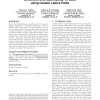Free Online Productivity Tools
i2Speak
i2Symbol
i2OCR
iTex2Img
iWeb2Print
iWeb2Shot
i2Type
iPdf2Split
iPdf2Merge
i2Bopomofo
i2Arabic
i2Style
i2Image
i2PDF
iLatex2Rtf
Sci2ools
ISSAC
2007
Springer
2007
Springer
Generation and optimisation of code using coxeter lattice paths
Supercomputing applications usually involve the repeated parallel application of discretized differential operators. Difficulties arise with higher-order discretizations of operators on parallel computers because their communications can overlap processors in complex ways. Their correct and efficient implementation requires careful choreography of computation and communication, taking into account the symmetries of the problem and of the computer’s communication network. This paper shows how these symmetries can be used to automate the construction of the code for optimized operator computation. This is done with considerable generality by making the symmetries both of the problem and the computer explicit using the language of finitely presented reflection (Coxeter) groups, and using coset enumeration to generate and optimize the required code. Categories and Subject Descriptors
| Added | 08 Jun 2010 |
| Updated | 08 Jun 2010 |
| Type | Conference |
| Year | 2007 |
| Where | ISSAC |
| Authors | Thomas J. Ashby, Anthony D. Kennedy, Stephen M. Watt |
Comments (0)

